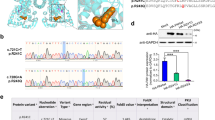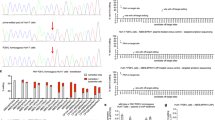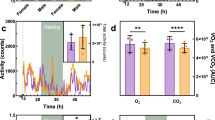Abstract
Phenylalanine hydroxylase (PAH) deficiency is responsible for most cases of phenylketonuria (PKU). In this study of the PAH mutation spectrum in the Taiwanese population, 139 alleles were identified including 34 different mutations. The V190G, Q267R and F392I mutations are first reported in this study. The most common mutations, R241C, R408Q and Ex6-96A>G, account for 23.2%, 12.0% and 9.2%, of the mutant alleles, respectively. Haplotype analysis shows that R241C and Ex6-96A>G are exclusively associated with haplotype 4.3 to suggest founder effects. On the other hand, R408Q is found on two distinct haplotypes suggesting recurrent mutations. The spectrum of PAH mutations in Taiwan shows various links to those of other Asian regions, yet remarkable differences exist. Notably, R408Q, E286K and −4173_−407del, accounting for 21% of all mutant alleles in Taiwan, are very rare or are undetected among PKU cohorts of other Asian regions to suggest local founder effects. Moreover, the low homozygosity value of 0.092 hints at a high degree of ethnic heterogeneity within the Taiwanese population. Our study of PAH mutation spectrum and the associated haplotypes is useful for subsequent study on the origin and migration pattern via Taiwan, an island at the historical crossroad of migration of ancient populations.
Similar content being viewed by others
Log in or create a free account to read this content
Gain free access to this article, as well as selected content from this journal and more on nature.com
or
References
Guldberg, P., Rey, F., Zschocke, J., Romano, V., Francois, B., Michiels, L. et al. A European multicenter study of phenylalanine hydroxylase deficiency: classification of 105 mutations and a general system for genotype-based prediction of metabolic phenotype. Am. J. Hum. Genet. 63, 71–79 (1998).
Eisensmith, R. C., Okano, Y., Dasovich, M., Wang, T., Güttler, F., Lou, H. et al. Multiple origins for phenylketonuria in Europe. Am. J. Hum. Genet. 51, 1355–1365 (1992).
Kidd, J. R., Pakstis, A. J., Zhao, H., Lu, R. B., Okonofua, F. E., Odunsi, A. et al. Haplotypes and linkage disequilibrium at the phenylalanine hydroxylase locus, PAH, in a global representation of populations. Am. J. Hum. Genet. 66, 1882–1899 (2000).
Zschocke, J. Phenylketonuria mutations in Europe. Hum. Mutat. 21, 345–356 (2003).
Scriver, C. R. The PAH gene, phenylketonuria, and a paradigm shift. Hum. Mutat. 28, 831–845 (2007).
Guldberg, P., Levy, H. L., Hanley, W. B., Koch, R., Matalon, R., Rouse, B. M. et al. Phenylalanine hydroxylase gene mutations in the United States: report from the Maternal PKU Collaborative Study. Am. J. Hum. Genet. 59, 84–94 (1996).
Blundell, D. Taiwan-Linguistics, History and Prehistory, (SMC Publishing: Taipei, Taiwan, 2000).
Wu, D. Y. H. In China Off Center: Mapping the Margins of the Middle Kingdom eds Blum S. D., Jenson L. M., 167–187 (University of Hawaii Press, 2002).
Chien, Y. H., Chiang, S. C., Huang, A., Chou, S. P., Tseng, S. S., Huang, Y. T. et al. Mutation spectrum in Taiwanese patients with phenylalanine hydroxylase deficiency and a founder effect for the R241C mutation. Hum. Mutat. 23, 206 (2004).
Chen, S. H., Hsiao, K. J., Lin, L. H., Liu, T. T., Tang, R. B. & Su, T. S. Study of restriction fragment length polymorphisms at the human phenylalanine hydroxylase locus and evaluation of its potential application in prenatal diagnosis of phenylketonuria in Chinese. Hum. Genet. 81, 226–230 (1989).
Chen, K. J., Chao, H. K., Hsiao, K. J. & Su, T. S. Identification and characterization of a novel liver-specific enhancer of the human phenylalanine hydroxylase gene. Hum. Genet. 110, 235–243 (2002).
Goltsov, A. A., Eisensmith, R. C., Konecki, D. S., Lichter-Konecki, U. & Woo, S. L. Associations between mutations and a VNTR in the human phenylalanine hydroxylase gene. Am. J. Hum. Genet. 51, 627–636 (1992).
Goltsov, A. A., Eisensmith, R. C., Naughton, E. R., Jin, L., Chakraborty, R. & Woo, S. L. A single polymorphic STR system in the human phenylalanine hydroxylase gene permits rapid prenatal diagnosis and carrier screening for phenylketonuria. Hum. Mol. Genet. 2, 577–581 (1993).
Zschocke, J., Graham, C. A., McKnight, J. J. & Nevin, N. C. The STR system in the human phenylalanine hydroxylase gene: true fragment length obtained with fluorescent labelled PCR primers. Acta Paediatr. (Suppl.) 407, 41–42 (1994).
Sambrook, J. & Russell, D. W. Molecular Cloning- A Laboratory Manual 3rd edn (Cold Spring Harbor Laboratory Press, 2001).
Ho, P. Y., Huang, M. Z., Fwu, V. T., Lin, S. C., Hsiao, K. J. & Su, T. S. Simultaneous assessment of the effects of exonic mutations on RNA splicing and protein functions. Biochem. Biophys. Res. Commun. 373, 515–520 (2008).
Cartegni, L., Chew, S. L. & Krainer, A. R. Listening to silence and understanding nonsense: exonic mutations that affect splicing. Nat. Rev. Genet. 3, 285–298 (2002).
Chao, H. K., Hsiao, K. J. & Su, T. S. A silent mutation induces exon skipping in the phenylalanine hydroxylase gene in phenylketonuria. Hum. Genet. 108, 14–19 (2001).
Okano, Y., Eisensmith, R. C., Guttler, F., Lichter-Konecki, U., Konecki, D. S., Trefz, F. K. et al. Molecular basis of phenotypic heterogeneity in phenylketonuria. N. Engl. J. Med. 324, 1232–1238 (1991).
Svensson, E., Eisensmith, R. C., Dworniczak, B., von Dobeln, U., Hagenfeldt, I., Horst, J. et al. Two missense mutations causing mild hyperphenylalaninemia associated with DNA haplotype 12. Hum. Mutat. 1, 129–137 (1992).
Dilella, A. G., Marvit, J., Brayton, K. & Woo, S. L. C. An amino-acid substitution involved in phenylketonuria is in linkage disequilibrium with DNA haplotype 2. Nature 327, 333–338 (1987).
Okano, Y., Asada, M., Kang, Y., Nishi, Y., Hase, Y., Oura, T. et al. Molecular characterization of phenylketonuria in Japanese patients. Hum. Genet. 103, 613–618 (1998).
Ketterling, R. P., Drost, J. B., Scaringe, W. A., Liao, D. Z., Liu, J. Z., Kasper, C. K. et al. Reported in vivo splice-site mutations in the factor IX gene: severity of splicing defects and a hypothesis for predicting deleterious splice donor mutations. Hum. Mutat. 13, 221–231 (1999).
Zekanowski, C., Nowacka, M., Cabalska, B. & Bal, J. Molecular basis of mild hyperphenylalaninaemia in Poland. J. Med. Genet. 34, 1035–1036 (1997).
Pey, A. L., Desviat, L. R., Gamez, A., Ugarte, M. & Perez, B. Phenylketonuria: genotype-phenotype correlations based on expression analysis of structural and functional mutations in PAH. Hum. Mutat. 21, 370–378 (2003).
Dobrowolski, S. F., Pey, A. L., Koch, R., Levy, H., Ellingson, C. C., Naylor, E. W. et al. Biochemical characterization of mutant phenylalanine hydroxylase enzymes and correlation with clinical presentation in hyperphenylalaninaemic patients. J. Inherit. Metab. Dis. 32, 10–21 (2009).
Song, F., Qu, Y. J., Zhang, T., Jin, Y. W., Wang, H. & Zheng, X. Y. Phenylketonuria mutations in Northern China. Mol. Genet. Metab. 86, S107–S118 (2005).
Leandro, P., Rivera, I., Lechner, M. C., de Almeida, I. T. & Konecki, D. The V388M mutation results in a kinetic variant form of phenylalanine hydroxylase. Mol. Genet. Metab. 69, 204–212 (2000).
Okano, Y., Hase, Y., Kawajiri, M., Nishi, Y., Inui, K., Sakai, N. et al. In vivo studies of phenylalanine hydroxylase by phenylalanine breath test: diagnosis of tetrahydrobiopterin-responsive phenylalanine hydroxylase deficiency. Pediatr. Res. 56, 714–719 (2004).
Okano, Y., Kudo, S., Nishi, Y., Sakaguchi, T. & Aso, K. Molecular characterization of phenylketonuria and tetrahydrobiopterin-responsive phenylalanine hydroxylase deficiency in Japan. J. Hum. Genet. 56, 306–312 (2011).
Lee, D. H., Koo, S. K., Lee, K. S., Yeon, Y. J., Oh, H. J., Kim, S. W. et al. The molecular basis of phenylketonuria in Koreans. J. Hum. Genet. 49, 617–621 (2004).
Zhu, T., Qin, S., Ye, J., Qiu, W., Han, L., Zhang, Y. et al. Mutational spectrum of phenylketonuria in the Chinese Han population: a novel insight into the geographic distribution of the common mutations. Pediatr. Res. 67, 280–285 (2010).
Eisensmith, R. C. & Woo, S. L. Updated listing of haplotypes at the human phenylalanine hydroxylase (PAH) locus. Am. J. Hum. Genet. 51, 1445–1448 (1992).
Weber, J. L. & Wong, C. Mutation of human short tandem repeats. Hum. Mol. Genet. 2, 1123–1128 (1993).
Lin, C. H., Hsiao, K. J., Tsai, T. F., Chao, H. K. & Su, T. S. Identification of a missense phenylketonuria mutation at codon 408 in Chinese. Hum. Genet. 89, 593–596 (1992).
Tsai, T. F., Hsiao, K. J. & Su, T. S. Phenylketonuria mutation in Chinese haplotype 44 identical with haplotype 2 mutation in northern-European Caucasians. Hum. Genet. 84, 409–411 (1990).
Murphy, B. C., Scriver, C. R. & Singh, S. M. CpG methylation accounts for a recurrent mutation (c.1222C>T) in the human PAH gene. Hum. Mutat. 27, 975 (2006).
Lin, M., Chu, C. C., Chang, S. L., Lee, H. L., Loo, J. H., Akaza, T. et al. The origin of Minnan and Hakka, the so-called ‘Taiwanese’, inferred by HLA study. Tissue Antigens 57, 192–199 (2001).
Moodley, Y., Linz, B., Yamaoka, Y., Windsor, H. M., Breurec, S., Wu, J. Y. et al. The peopling of the Pacific from a bacterial perspective. Science 323, 527–530 (2009).
Gray, R. D., Drummond, A. J. & Greenhill, S. J. Language phylogenies reveal expansion pulses and pauses in Pacific settlement. Science 323, 479–483 (2009).
Soares, P., Rito, T., Trejaut, J., Mormina, M., Hill, C., Tinkler-Hundal, E. et al. Ancient voyaging and Polynesian origins. Am. J. Hum. Genet. 88, 239–247 (2011).
Acknowledgements
We thank Dr K-B Choo for critical reading and editing of the manuscript. This work was supported by grants NSC 89-2320-B-075-051, NSC 90-2320-B-075-010 and NSC 91-2316-B-075-001 from the National Science Council and by grants VGH94-370-15, V95S4-021, V96S4-007, V97S4-015 and V98S4-010 from the Taipei Veterans General Hospital, Taiwan.
Author information
Authors and Affiliations
Corresponding authors
Rights and permissions
About this article
Cite this article
Liang, Y., Huang, MZ., Cheng, CY. et al. The mutation spectrum of the phenylalanine hydroxylase (PAH) gene and associated haplotypes reveal ethnic heterogeneity in the Taiwanese population. J Hum Genet 59, 145–152 (2014). https://doi.org/10.1038/jhg.2013.136
Received:
Revised:
Accepted:
Published:
Issue date:
DOI: https://doi.org/10.1038/jhg.2013.136
Keywords
This article is cited by
-
Genetic etiology and clinical challenges of phenylketonuria
Human Genomics (2022)
-
Probability of high-risk genetic matching with oocyte and semen donors: complete gene analysis or genotyping test?
Journal of Assisted Reproduction and Genetics (2022)
-
Molecular characterization of Thai patients with phenylalanine hydroxylase deficiency and in vitro functional study of two novel PAH variants
Molecular Biology Reports (2021)
-
Spectrum of PAH gene mutations in 1547 phenylketonuria patients from Iran: a comprehensive systematic review
Metabolic Brain Disease (2021)
-
Comparative analysis of functional assay evidence use by ClinGen Variant Curation Expert Panels
Genome Medicine (2019)



